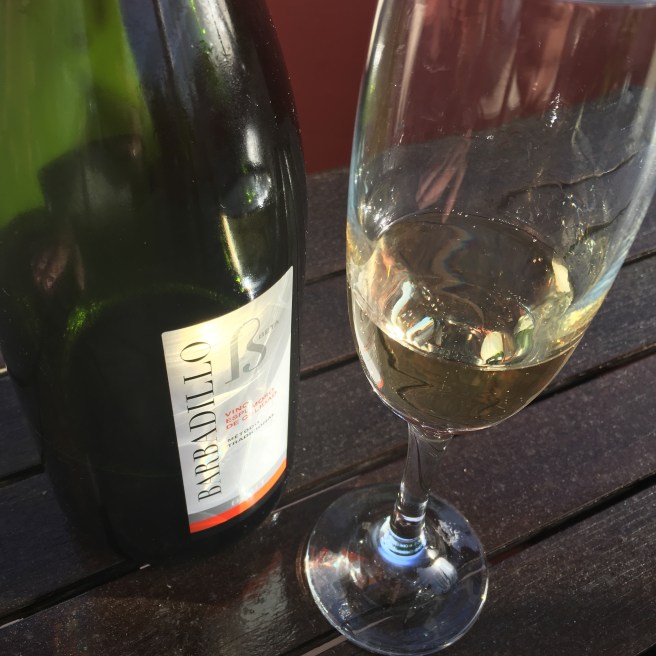
I finally finish writing up my notes of a really fun tasting at the end of June. It was a really good laugh for a number of reasons, but at least in part because these wines seem to have fun embedded in their DNA. Seven bottles in total, four bubbles (two ancestral and two brut, of which one was rosé) and three dry white wines.
First up was the Ancestral Alegrías del Carrascal 2015 – 11,5%, 100% from 50 year old palomino fino vines from the Alegrías vineyard on pago Carrascal (de Sanlúcar). 2015 was a very hot year and the wine was fermented in 1000l stainless steel tanks for 14 days before being bottled at the end of September. No added ingredients here and while we had tasted one with 7 months on the rack last year this one had a further 12 months before disgorging. A curious combination of the most vertical and atlantic of the Sanlúcar pagos in one of the warmest recent years, it was fresh and very amenable, the slight residual sugar making it very appetising, with nice tight bubbles, appley sweetness and fresh grass, a touch of salinity and a slightly bitter finish.
Second came the Ancestral Confitero 2015 – 11,9% vol – from 35 year old vines on the El Confitero vineyard on pago Miraflores (just inland of Carrascal), very near to the legendary “Armijo” of Gaspar Florido. Again ancestral method with only 3 gr/Hl of so2 before pressing and no additives. This one was fermented in plastic containers for 12 days before bottling then spent 17 months on the rack was disgorged by hand and refilled with the same wine. Pretty decent bubbles these – a bit broader in the shoulders flavourwise but didn’t hold together quite as well. A bit more serious, more wine/vine/root-like, not quite as much residual sugar and less of a defined shape.
After the ancestral wines we turned to the methode champenoise wines, starting with the Brut Nature 2014. This comes from palomino fino from different Sanlúcar pagos, is fermented in stainless steel at controlled temperatures, then aged in deposit, initially with a little flor for around 5 months. Then it is put in 16 litre demijons for six months where flor again develops. Then it is bottled and has spent 25 months on the rack. Once again, only 4gr/Hl of so2 before pressing. The result is a quality bottle of bubbles – tighter, sharper bubbles – with a bit more bite and crispness. Has those same apple and herb aromas and flavours and a compact, elegant profile. Really top class and probably my favourite wine on the day.
That was followed by the Brut Nature Rosado 2014, pink bubbles made from 93% palomino fino and 7% tintilla de rota, all grown on vineyards in Sanlúcar. Fermented in stainless steel and bottled in June 2015, with 25 months on the rack. 3 gr/Hl of so2 added before pressing and then no other additives, disgorged by hand and refilled with the same wine. Again a quality bottle of sparkling wine and full flavoured, with quite brash red fruit flavours and a bit of the heavy metal effect you get from cavas with a lot longer on the rack. Again bags of potential here.
The first of the still wines was the Alba sobre tabla 2014 (Bota 2). 100% palomino fino from different vineyards in Sanlúcar, a white wine fermented in stainless steel and aged there until January 2015, when it was put in a manzanilla butt. For the 2014 vintage there were three butts of Sobre Tabla: Butt III was bottled in August 2015, Butt I was bottled in March 2016 (and was part of last year’s tasting) and Butt II was bottled earlier in 2017. None of the three butts developed flor except this Butt II which saw some develop in the last few months. The wine was excellent and there was general agreement that of the wines tasted it was the wine with most fruit and, at the same time, oxidated “sherry” character. Has a nice tingle of salinity/acidity and ripe apples on the nose and palate and a slightly tingling, mineral finish.
That was followed by Alba Flor 2014, essentially the same wine but whereas the Sobre Tabla was in a butt that was filled to the top this one was placed into a three quarter full butt for four months under flor. I must admit I found it hard to spot the difference between this and the previous wine. Slightly finer maybe? By a hair’s breadth if anything. Then again it was my sixth wine of a very enjoyable lunch. Still a very fragrant, tasty white wine by any measure.
The final wine was La Charanga 2014, from the eponymous vineyard in pago Mahina. This wine is from the oldest and best palomino fino vines tended by legendary mayeto “el Bolli”, on a vineyard that faces West to the breezes from Doñana. The wine was fermented in an oloroso butt and was aged for a year in a manzanilla butt. I had placed this wine last in the order on the basis of it’s being from the beefiest of the Sanlúcar pagos and a memory of it having a fair structure to it but on the day it came across as lighter and more floral than I expected. Nice slightly sweet floral/herb flavours and a long elegant finish.
Seven quality, imaginative and well made wines, a lot of fun and yet again a demonstration of the value of what can be achieved by working the vintage and the vineyard.








